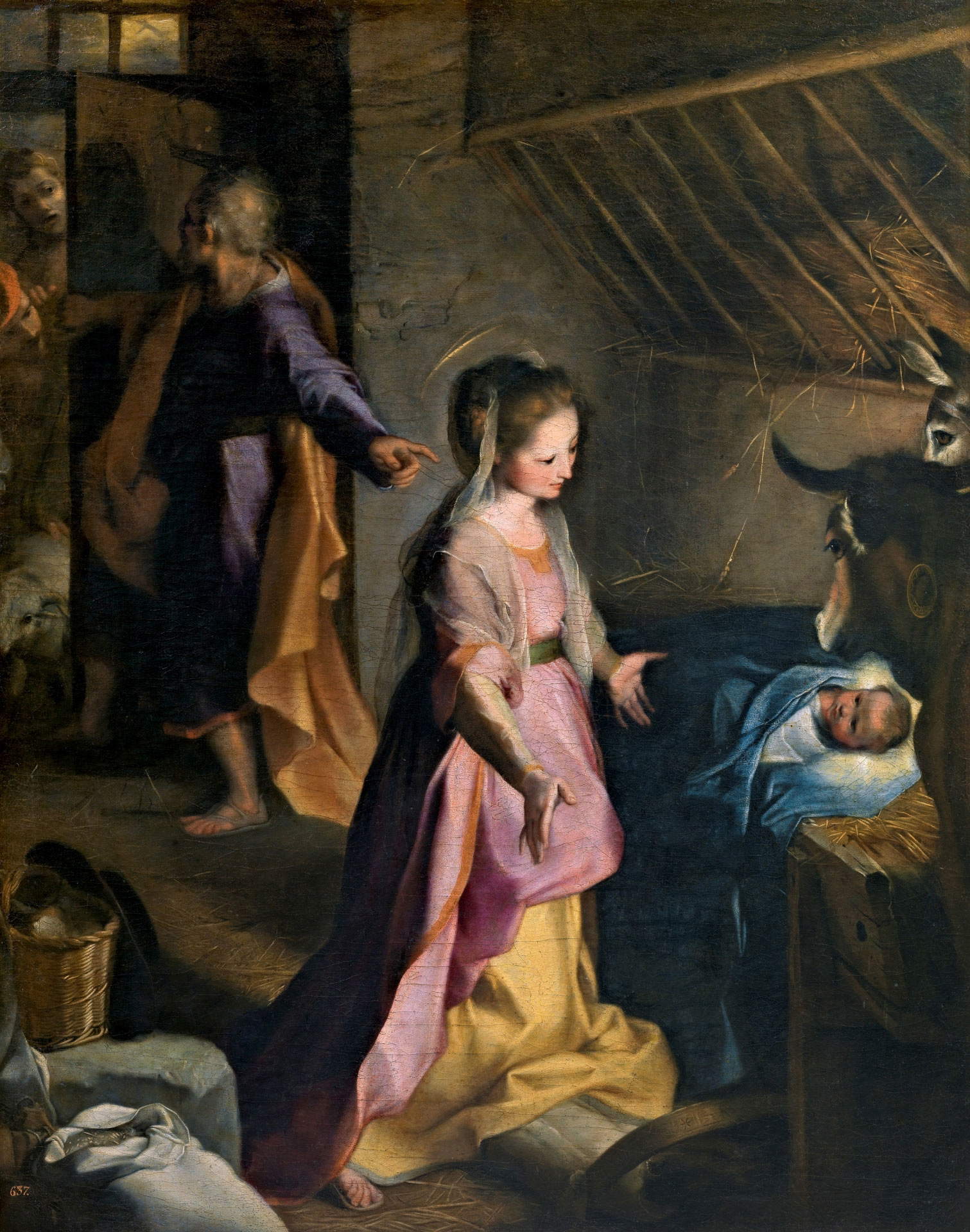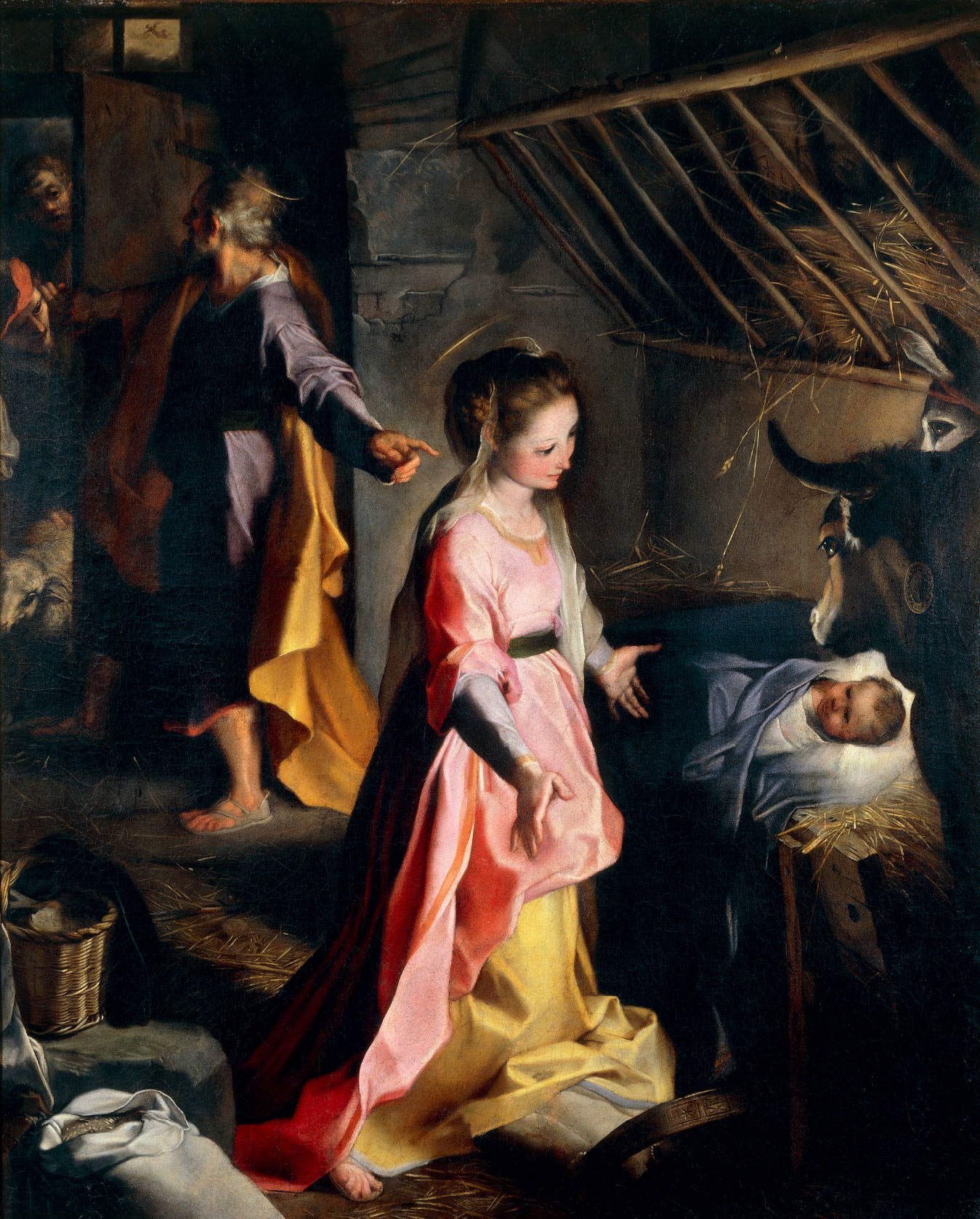The Nativity is one of the most widely represented themes in the history of art: there are hundreds of depictions of the birth of the Infant Jesus that follow the more traditional manger arrangements of the nativity scene or show scenes full of characters who arrive specifically before the Child to celebrate the happy event. Reflecting on which work might be best suited to represent this Christmas 2020, which will probably be remembered as the most collected and restricted, if not lonely, Christmas in recent times, I thought of one of the most intimate Nativities ever created: the Nativity by Federico Barocci (Urbino, 1535 - 1612).
The protagonist of the scene is in fact only the Holy Family with the inevitable ox and donkey; two shepherds are then added, but they remain on the threshold and look out to see inside, along with a sheep, from the door held ajar by St. Joseph. Having arrived to adore the Child, the Savior of the world, the shepherds appear almost outside the scene, which on the contrary is intended to give main prominence to the newborn and the new parents, emphasizing the more intimate and familiar aspect of the event. The stable becomes a domestic setting reserved for the Holy Family alone, where adoring the Baby Jesus, placed on a manger filled with hay and wrapped in his mother’s ample blue cloak with a snow-white pillow on which rests the delicate little head, are the Virgin, and the ox and the donkey who at the same time warm him with their breath. The young mother with fine and delicate features, with a slight blush on her cheeks, turns her gaze in adoration of her creature; she is on her knees and holds her arms out in veneration. Her hair is gathered under a transparent veil, and her head is encircled with a halo; she wears a soft pink robe cinched at the waist that reaches down to the ground, from which a foot sprouts, and an ochre-colored petticoat. The Virgin and Child exchange an intense, loving gaze with each other that expresses all the sweetness between a mother and child. The former, in the center of the scene, also appears completely frontally lit: the setting has neither natural nor artificial lighting, but it is the Child himself who emanates light. This is referred to as mystical naturalism: everything is flooded by the divine light emanating from the face of the Child Jesus.
In the lower left corner we notice some objects: a basket resting on a stone, St. Joseph’s hat, a sack. A small still life that gives the painting a sense of home, of everyday life. The whole work is pervaded by the familiar warmth: it seems that the environment is warmed by a warm glow, but in fact, if one pauses to observe each detail carefully, the only “source” of warmth present is the breath of the two animals turned tenderly toward the newborn baby. St. Joseph has just moved away from the manger to move slightly away from the door of the stable, behind which the figures of the shepherds and a little sheep are glimpsed: these remain amazed by so much beauty, by so much light emanating from the little creature. They remain at the doorway, as if to leave that kind of family quiet intact, while St. Joseph points to the newcomer.
The divine advent is represented with great affective participation: in the Nativity, Federico Barocci brings to its highest expressive heights the so-called poetics of the affections, already masterfully used by Leonardo, Raphael, and especially Correggio, whose influence Barocci feels strongly. The gentle atmosphere involves the emotional aspect of the composition; the human and divine planes are juxtaposed for an enveloping and intimate narrative of the biblical subject. The divine is embodied in the strong light that spreads throughout the painting from the Child, but at the same time the sacred figures narrate the happy event of the birth of a child from the human point of view, with humility and simplicity. Barocci was able to create, thanks to the naturalness and great mastery of his painterly means, a work imbued with grace, refinement, devotion and affectivity, an atmosphere in which the divine is combined with the human in an extraordinary expressiveness and intensity, especially in that stupendous aura on the right side of the painting.
 |
| Federico Barocci, Nativity (1597; oil on canvas, 134 x 105 cm; Madrid, Museo del Prado) |
 |
| Correggio, Adoration of the Shepherds or La Notte (c. 1528-1530; oil on panel, 256.5 x 188 cm; Dresden, Gemäldegalerie) |
 |
| Alessandro Vitali (from Federico Barocci), Nativity (1599; oil on canvas, 135.4 x 110 cm; Milan, Pinacoteca Ambrosiana) |
After his second sojourn in Rome between 1561 and 1563, in which he devoted himself to the frescoes in the Casina of Pius IV in Vatican City on the vault of the Sacred Conversation room, fitting into the Raphaelesque tradition to which Taddeo Zuccari belonged, Barocci had already grappled with the poetics of the affections and in this juxtaposition of the human and the divine in the celebrated Annunciation completed between 1582 and 1584 for the chapel of the Duke of Urbino Francesco Maria II della Rovere in the Basilica of Loreto: here, too, we see a very lyrical and intimist language and a simple and immediate rendering of the biblical theme of the Annunciation, accompanied by striking colorism and luministic effect .
Even in terms of the divine value Barocci gives to the light that spreads from the Baby Jesus himself, the artist is greatly influenced by Correggio (he probably saw his masterpieces in Parma): indeed, one of the most beautiful nocturnes in the history of art, theAdoration of the Shepherds (1525 - 1530) from the Gemäldegalerie in Dresden, better known as La Notte, comes to mind, in which the Child in the arms of the Virgin radiates a sacred light.
Now housed in the Prado Museum, Barocci’s Nativity was made in 1597 on commission from Francesco Maria II della Rovere, duke of Urbino, and in 1605 the latter gave it to Margaret of Austria, wife of Philip II of Spain. Here, then, is the reason why the painting can be admired in Madrid today.
The artist here stylistically combines Venetian-print colorism, particularly evident in the figure of the Virgin, with the aforementioned mystical naturalism. Treatiseist and painter Giovanni Paolo Lomazzo described Barocci as one of Correggio’s followers “who gave to their paintings the strength and readiness of motion and the gracefulness of color.” Harmony of colors but also harmony of features achieved through numerous studies prior to the creation of the final work. Lomazzo himself highlighted the use of light as a strategic element to bring out the compositional and affective color texture of the works. In a sonnet in which he praised the artist, published in 1589, he extolled his “rar maneggio / dei lumi et ombre [che Federico] dal natural prese” and the correggesque qualities of the foreshortenings. Barocci is considered a precursor of Baroque art, as he depicts religious scenes with realism and emotional immediacy.
An identical replica of the Prado Nativity is on display at the Ambrosiana in Milan, and there has been much debate about its authorship: scholars have recently claimed that it is a faithful copy. It was made in about 1599 by Alessandro Vitali, a pupil of Barocci. According to letters from Federico Borromeo, the latter commissioned the Nativity scene in December 1598, when he was in Urbino, shortly after Barocci’s original executed for the duke. He received the painting in August the following year and was fully satisfied with it, as it met his tastes: he called it “one of the dearest things I have,” and probably kept it on display in his studio in the archbishop’s palace. It was not until his death that the work became part of the Ambrosian collection, where it can still be admired, although it constitutes a replica of a stupendous Baroque original.
Warning: the translation into English of the original Italian article was created using automatic tools. We undertake to review all articles, but we do not guarantee the total absence of inaccuracies in the translation due to the program. You can find the original by clicking on the ITA button. If you find any mistake,please contact us.